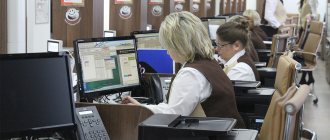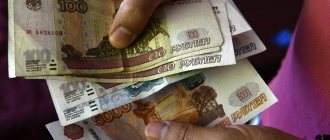| Pension Fund of the Russian Federation | |
| Pension Fund | |
| Type of organization | Pension Fund |
| Managers | |
| Chairman of the Board | Drozdov Anton Viktorovich |
| Base | |
| Date of foundation | December 22, 1990 |
| Number of employees | 114,300 (in 2020)[1] |
| pfrf.ru | |
| Pension Fund of the Russian Federation on Wikimedia Commons | |
The Pension Fund of the Russian Federation
(
PFR
) is the largest organization in Russia providing socially significant public services to citizens. Founded on December 22, 1990 by Resolution of the Supreme Council of the RSFSR No. 442-1 “On the organization of the Pension Fund of the RSFSR”[2].
As a state extra-budgetary fund of the Russian Federation, the Pension Fund of the Russian Federation was created for the state management of funds of the pension system and ensuring the rights of citizens of the Russian Federation to pension provision. The budget of the Pension Fund of the Russian Federation is approved by the State Duma of the Federal Assembly of the Russian Federation in a separate law, together with the adoption of the Federal budget of the Russian Federation. The share of the Pension Fund's budget in Russia's GDP is 10.8% in terms of income and 10.2% in terms of expenses. The Pension Fund of the Russian Federation pays pensions to over 40 million pensioners[3] and social benefits to 20 million beneficiaries, and maintains personalized records of the pension rights of insured persons[4] - for over 128 million Russian citizens.
Since 2005, there has been a deficit in the pension system, which is covered by transfers from the budget. However, the deficit of the pension system is several times smaller than the deficit of the pension fund, due to the transfer of social obligations unrelated to the payment of pensions to the Pension Fund[5]. According to Nikita Krichevsky, until 2005, the Russian pension fund had a budget surplus: in 2003 - 100 billion, in 2004 - more than 66 billion rubles[6].
Pension Fund structure
The structure of the Pension Fund includes 8 Directorates in the Federal Districts of the Russian Federation, 83 Branches of the Pension Fund in the constituent entities of the Russian Federation, a branch in Baikonur (Kazakhstan), as well as about 2,500 territorial directorates in all regions of the country. The Pension Fund system employs more than 100,000 workers[7]. The highest body is the Board of the Pension Fund; the Executive Directorate of the Pension Fund is responsible for its executive functions.
In relations with policyholders, insured persons and pensioners, the territorial departments of the Pension Fund of the Russian Federation are separate legal entities[8].
Socially significant functions of the Pension Fund
Among the socially significant functions of the Russian Pension Fund[7]:
- appointment and payment of pensions;
- accounting of insurance funds received under compulsory pension insurance;
- assignment and implementation of social payments to certain categories of citizens: veterans, disabled people, disabled people due to military trauma, Heroes of the Soviet Union, Heroes of the Russian Federation, etc.;
- personalized accounting of participants in the compulsory pension insurance system;
- interaction with policyholders (employers - payers of insurance pension contributions), collection of arrears;
- issuance of certificates for receiving maternity (family) capital;
- payment of maternity capital funds;
- management of pension system funds;
- implementation of the Program of state co-financing of voluntary pension savings (56-FZ of April 30, 2008, also known as the “thousand for a thousand” program);
- since 2010 - administration of insurance funds received under compulsory pension insurance and compulsory medical insurance;
- since 2010 - the establishment of a federal social supplement to social pensions in order to bring the total income of a pensioner to the pensioner’s subsistence level.
Personalized accounting in the compulsory pension insurance system
Data on the payment by policyholders (employers) of mandatory insurance premiums for an employee, information on insurance (work) experience are reflected on the individual personal account of the insured person, which is maintained by the Pension Fund of the Russian Federation for each officially working citizen of Russia. The procedure for maintaining this personal account is regulated by Federal Law dated April 1, 1996 N 27-FZ (as amended on December 29, 2015) “On individual (personalized) accounting in the compulsory pension insurance system”[4]. Any citizen of the Russian Federation who has a SNILS can check information about the payment of mandatory insurance contributions by his employer on his individual personal account with the Pension Fund of Russia using the Internet portal “Gosuslug”[9].
Functions of the pension fund today
The main goal of the Pension Fund, for which the decision to create the fund was made, is to manage funds used to support the pension system in the country. This is expressed in the accumulation of money supplied to the fund through mainly insurance contributions, and in the payment of pensions to citizens entitled to it. The Pension Fund of Russia still copes with this task today.
In addition, the functions of this organization include:
- administration of a personalized accounting system;
- co-financing of certain social programs;
- monitoring the receipt of insurance premiums and supervising the fulfillment by policyholders of their obligations under compulsory insurance;
- issuing certificates of maternal capital and monitoring the expenditure of its funds.
Important! At the moment, the Russian Pension Fund is also one of the largest employers - in total, more than 100 thousand people work in its structures.
Contributions - income of the Pension Fund
See also Compulsory social insurance in Russia.
The standard rate of contributions to the Pension Fund is 22% of the organization’s payroll, while contributions are not included in the salaries of individual employees, but are taken into account by the pension fund when maintaining their accounts[10]. These contributions are divided into the insurance part and the funded part of the pension.
Until 2010, contributions to the Pension Fund were taken into account as part of the unified social tax.
From January 1, 2010, the unified social tax was abolished, and instead direct insurance contributions of employers (policyholders) to three extra-budgetary funds were established: the Pension Fund of the Russian Federation, the Federal Compulsory Medical Insurance Fund and the Social Insurance Fund. In 2010, the total volume of insurance contributions will remain at the level of the Unified Social Tax rate - 26%, of which 20% will be directed to the Pension Fund of the Russian Federation (for compulsory pension insurance). In this case, contributions will be paid from annual earnings up to 415 thousand rubles. If annual earnings exceed 415 thousand rubles, contributions in excess of 415 thousand rubles are not collected, but pension rights in excess of this amount are not formed. From 2011, the amount of total contributions will increase to 34%, of which 26% will be contributions for compulsory pension insurance. This system makes it possible to significantly increase the level of pensions in the country. For persons who are fully covered by the insurance system, the coefficient of replacement of wages with a pension with which insurance premiums were paid will be at least 40% after 30 years of paying these contributions upon the occurrence of an insured event (that is, old age, determined by the citizen reaching the age established by law - 55 years for women and 60 years for men).
Also, since 2009, citizens have the opportunity to make voluntary contributions to the funded part of their pension. The law[11] provides for two parties to co-financing a citizen’s contributions - the state (which doubles the amount to at least 2 thousand, but not more than 12 thousand rubles) and the employer (which receives a tax deduction for co-financing employee contributions up to 12 thousand rubles).
Part of the long-term pension provision mechanism for citizens of the Russian Federation is the Russian National Welfare Fund[12]. As of April 2020, according to the Russian Ministry of Finance, the total volume of the fund amounted to 4,134.27 billion rubles (73.33 billion US dollars)[13].
Before transferring funds to management companies and non-state pension funds, the Pension Fund temporarily places them in commercial banks. Thus, according to the results of 2016, he received an income from such investment in the amount of 2.97 billion rubles, which is 10.58% per annum[14].
History of the Pension Fund
The year 1956 in Russian history was marked by the famous 20th Congress of the CPSU, where the personality cult of Joseph Stalin was officially debunked, as a result of which fundamental changes were initiated in the social life of Soviet society. However, this date is also significant because with the release of the law “On State Pensions,” workers and employees could count on receiving a monthly cash disability benefit in old age.
Reference! In 1964, this right, although in a somewhat truncated form, also became available to residents of rural areas working on collective farms. Since this time, we can say that the pension system has fully developed in the Soviet Union.
At that time, the country's economy was completely under state control. Management of local organizations and enterprises was carried out within the framework of the Soviet planning doctrine. In this regard, the state, in fact, was the only employer, and therefore the pension was paid from the country’s budget.
At the end of the Soviet era, the economy and public administration system found themselves in a deep crisis. In this regard, the state distanced itself from fulfilling its obligations under the new conditions. Against this background, in 1990, the Russian Pension Fund was created , which, although it remained a state organization, had a certain degree of independence, and the funds at the disposal of the Pension Fund of the Russian Federation were not part of the budget at any level.
Over the last decade of the 20th century, the Pension Fund experienced significant difficulties with occupancy, however, as the economic situation in the country improved, the pension system stabilized, although it is being actively reformed, including in the modern period.
Performance indicators
| Index | 2010[15] | 2011[16] | 2012[17] | 2013[18] | 2014[19] | 2015[20] | 2016[1] | 2017[21] |
| Number of pensioners, million people | 39,7 | 40,2 | 40,6 | 41,1 | 41,46 | 42,7 | 42,9 | 43,5 |
| Budget revenues of the Pension Fund of Russia, billion rubles | 4 600 | 5 256 | 5 890 | 6 388 | 6 159 | 7 127 | 7 626 | 8 260 |
| Receipt of contributions for compulsory pension insurance, billion rubles | 1 900 | 2 815 | 3 026 | 3 459 | 3 694 | 3 864 | 4 132 | 4 482 |
| Receipts from the federal budget, billion rubles | 2 640 | 2 400 | 2 800 | 2 840 | 2 410 | 3 100 | 3 355 | 3 677 |
| Pension Fund budget expenditures, billion rubles | 4 200 | 4 922 | 5 451 | 6 379 | 6 190 | 7 670 | 7 830 | 8 319 |
| Pension Fund expenditures on pensions, billion rubles | 3 700 | 4 081 | 4 524 | 5 250 | 5 406 | 6 201 | 6 430 | 7 167 |
| Pension Fund expenses on maternity capital, billion rubles | 97,1 | 171,3 | 212,4 | 270,7 | 365 | 312 |
Scandals
In February 2020, the Anti-Corruption Policy Center of the Yabloko party (ACP) discovered a contract according to which the Russian Pension Fund (PFR) will spend 27 million rubles on business trips for employees in 2020 without bidding.[22] In May 2020, the FAS confirmed violations when the Pension Fund spent 150 million rubles on employee business trips.[23]
Since mid-2020, on the basis of its internal letter (signed by the Deputy Chairman of the Board Liliya Ivanovna Chizhik), the Pension Fund of the Russian Federation has been refusing to provide monthly additional financial support (330% of the social pension) to laureates of the Russian Government awards who retire and stop working . As a result, they find themselves in significantly worse material conditions than the laureates who applied for the bonus earlier and are still receiving it. There were lawsuits initiated by the affected pensioner laureates. Most of them were won[24][25].
Efficiency and efficiency
The Russian Pension Fund ranks first in the world in terms of the number of employees: 121,670 people. For example, the number of employees of the Social Security Administration in the United States is more than two times smaller, and the population of the United States is more than twice that of Russia, and the volume of pension and social benefits is almost nine times larger. In Japan, with a population similar to Russia, Nihon Nenkin Kikou employs 27 thousand people, of which only 15 thousand work on a permanent basis[26].
Professor of the Department of Finance and Prices of the Russian Economic University. G.V. Plekhanova Yulia Finogenova noted that the Pension Fund of the Russian Federation has extremely limited obligations to inform its participants, for example, the Pension Fund of the Russian Federation did not have the obligation to inform clients about possible losses of investment income when changing insurers, as a result, in some years, up to 90% of transitions turned out to be premature, and therefore unprofitable[27]. Due to the lack of full information to the insured person about the loss of investment income, even those who decided to transfer from the Pension Fund of Russia (PFR) to non-state pension funds (NPFs) were “silent” [28] who lost out on an early transfer, since they could have done this with the preservation of income no earlier than 2020 [29].
The Pension Fund is also known for its involvement in a scandal involving illegal transfers of pension savings from the Pension Fund to NPFs.
In August 2020, against the backdrop of a discussion of the Draft Law on Pension Reform in Russia, which envisages an increase in the retirement age, Boris Titov, Commissioner under the President of the Russian Federation for the Protection of the Rights of Entrepreneurs, drew attention to the fact that one of the main reasons for the lack of funds for paying pensions in Russia is exorbitant and senseless expenses for the maintenance of the Pension Fund of the Russian Federation. The business ombudsman considered the infrastructure of the fund to be costly and unnecessary in the context of the development of information technology, and proposed transferring the functions of the Pension Fund to the Russian Treasury and Multifunctional Centers (MFC). In 2020, the Pension Fund of the Russian Federation employs more than 110 thousand officials to maintain the pension accounts of Russians, the buildings it owns are the most luxurious in all republican capitals and regional centers, and about 1.5% of all pension savings of Russians are spent annually on servicing the Pension Fund of the Russian Federation itself (this is tens of billion rubles). Numerous buildings of the Pension Fund throughout Russia, according to this action plan, should be transferred to the ownership of the constituent entities of the Federation for the organization of centers for training older people in new qualifications. Such measures will allow the state to free up significant reserves for paying pensions without increasing the retirement age[30].
History of the Pension Fund
On June 12, 1990, the Declaration of State Sovereignty of Russia was adopted. From this time on, the new history of the country and the reorganization of all state institutions began. It is noteworthy that the first testing grounds for radical modernization of the socio-economic structure of the new Russia were the spheres of education and social security. Already on November 20, 1990, the federal law “On State Pensions in the Russian Federation” was adopted. This law marked the beginning of the formation of a new type of pension system in Russia, completely autonomous from the all-Union budget of the USSR, which ceased to exist at the end of 1991. The new pension law of Russia was considered quite radical for its time, taking into account the acute political and socio-economic crisis throughout the post-Soviet space. All systems of personal, sectoral, regional and other social benefits and differentiated pension supplements previously operating in the country were abolished. Instead, a unified Russian pension system was established. In accordance with Article 1 of the Law “On State Pensions in the Russian Federation”, the main criterion for differentiating the conditions and standards of pension provision was recognized as “labor and its results”. Accordingly, instead of the previous extensive and multi-level pension system, only two types of pensions were established: labor and social. At the same time, all foreign citizens (including residents of other republics of the former USSR), as well as stateless persons permanently or temporarily residing in the territory of the Russian Federation, had the right to receive a pension on the same basis as citizens of the Russian Federation.
At the first stage, the pension system for Russian citizens continued to function on the basis of the distribution scheme of the Soviet period. The pension budget was replenished through deductions from the general wage fund of enterprises. But in the context of the transition to a market economy, which was accompanied in the early 90s by mass unemployment and bankruptcy of many large (budget-forming) enterprises, further support of the consolidated pension system became impossible. To fulfill the state's social obligations, it was necessary to search for more advanced financial mechanisms that would meet new economic realities.
These tasks were assigned to a new credit and financial organization - the Pension Fund of Russia (PFR), which was founded on December 22, 1990. For the first time in the country, an autonomous off-budget system for financing social benefits and generating sources of pension capital was created. During 1991-1992 branches of the Russian Pension Fund were created in all subjects of the Federation.
Pension Fund funds were formally separated from the federal budget, but remained the property of the Russian Federation. This structure for managing pension funds was not typical for foreign pension models, but it played an important role in the further development of the social insurance system in Russia. Including providing a certain degree of protection of pension capitals during periods of financial and economic destabilization.
The first budget of the Pension Fund was formed in conditions of an acute crisis of non-payments. Therefore, one of the first practical steps of the newly created financial organization was to attract borrowed funds from commercial banks in the amount of 6.6 billion rubles. Thus, the Pension Fund solved the problem of paying off the debt of the union and republican budgets for the payment of pensions and social benefits for 1991.
Already at the first stage of the Pension Fund's work (in 1991-1994), despite numerous difficulties, the work of the pension system was stabilized. The number of Russian pensioners has increased due to the extension of new pension conditions to creative workers, clergy, individual entrepreneurs and other categories of working citizens who, for various reasons, were not included in the country’s pension system until 1990.
A sharp deterioration in the macroeconomic situation and rising inflation in the first half of the 1990s. led to a sharp decline in the real purchasing power of pension payments. In order to prevent pensioners from becoming impoverished, the Russian government decided to regularly index pensions, giving priority to supporting the least wealthy citizens. In November 1993, a fixed compensation supplement was introduced to all pensions, comparable to the minimum old-age pension. This made it possible to increase the income of pensioners in real terms. Already at the beginning of 1994, the growth of pensions in Russia outpaced the growth of wages, and the average pension exceeded the subsistence level of a pensioner. In addition, for the first time, recipients of labor and social pensions lost their leadership in the list of the poorest categories of Russian citizens to single-parent families with children and large families.
Modernizing the social protection system and improving the standard of living of the most vulnerable part of the population became one of the priority goals of the government's subsequent social reforms, which were carried out with the direct participation of the Russian Pension Fund. In the course of a whole complex of radical pension and social security reforms carried out in Russia over the past 25 years, the functions of the Pension Fund have expanded significantly. In addition to paying labor and social pensions, the Pension Fund of Russia pays all types of benefits to preferential and low-income categories of citizens; issuance of state certificates for family (maternity) capital to each family at the birth of a second and subsequent child; implementation of the state co-financing program for pensions; formation, investment and payment of funds from the funded part of the pension capital of participants in the social insurance system and many other functions.
In 2020, the pension and social security system in the Russian Federation included more than 43 million pensioners, which constitutes more than half of the economically active population of Russia (more than 76 million people). About 16 million people became participants in the state pension co-financing program. More than 7 million families with children became recipients of certificates for family (maternity) capital, and more than 90 percent of them used a lump sum payment to improve their living conditions.
Currently, the Russian Pension Fund, on the basis of international agreements, makes pension payments in 109 countries around the world. Among the foreign countries with which the Russian Federation has concluded agreements on mutual pension provision, the largest number of recipients of Russian pensions live in the Republic of Belarus, Latvia, Bulgaria, Estonia and Ukraine. At the same time, of all the countries with which the Russian Federation does not yet have such agreements, the largest number of Russian pensioners live in Germany, Israel, the USA, Canada and Finland.
But reform of the pension system in the Russian Federation is still far from complete. In 2013, the Russian Pension Fund began implementing a new Strategy for the long-term development of the Russian pension system. One of the key goals of the Strategy is the development of a three-tier pension system model based on compulsory pension insurance, corporate pension systems and voluntary pension insurance. It is this model, which is being implemented in Russia from January 1, 2020, that will be able to ensure the greatest balance in the country’s pension system in the long term.
Notes
- ↑ 12
Annual report of the Pension Fund for 2020 - Resolution of the Supreme Council of the RSFSR No. 442-1 “On the organization of the Pension Fund of the RSFSR” Archived on January 20, 2013.
- Pension Fund of the Russian Federation - In November 2010, there were no failures in the payment of pensions and benefits
- ↑ 12
Federal Law “On individual (personalized) registration in the compulsory pension insurance system” dated 01.04.96 N 27-FZ - Nikita Krichevsky: Statements that the Pension Fund of Russia does not have a budget deficit are hypocrisy
- Personal blog of Nikita Krichevsky. About Nikita Isaev and the Pension Fund budget deficit
- ↑ 12
About the Pension Fund - Participants in legal relations regarding compulsory pension insurance. base.garant.ru. Retrieved April 2, 2020.
- Article 16. Rights and obligations of the bodies of the Pension Fund of the Russian Federation related to the implementation of individual (personalized) accounting / ConsultantPlus. www.consultant.ru. Retrieved April 2, 2020.
- Federal Law of December 15, 2001 N 167-FZ “On Compulsory Pension Insurance in the Russian Federation”
- Federal Law of April 30, 2008 N 56-FZ (as amended on July 27, 2010) “On additional insurance contributions for the funded part of the labor pension and state support for the formation of pension savings”
- “The Purpose of [NWF]”
- National Welfare Fund. Statistics.
- At the end of 2020, the Pension Fund increased the pension savings of Russians by 2.97 billion rubles. www.pfrf.ru (April 6, 2017). Retrieved April 18, 2020.
- Annual report of the Pension Fund for 2010
- Annual report of the Pension Fund for 2011
- Annual report of the Pension Fund for 2012
- Annual report of the Pension Fund for 2013
- Annual report of the Pension Fund for 2014
- Annual report of the Pension Fund for 2020
- Annual report of the Pension Fund for 2020
- Inc., TV Rain,
. Yabloko learned about the Pension Fund's plans to spend 27 million rubles on business trips for employees. Retrieved May 20, 2020. - Inc., TV Rain,
. FAS found violations when the Pension Fund spent 150 million rubles on business trips for employees. Retrieved May 20, 2020. - “Reckoning with the laureates” // Moscow city branch of the Communist Party of the Russian Federation, official website.
- The Pension Fund is deceiving the laureates of the Russian Government Prize. trv-science.ru
- Fund with more Rating of the most effective and ineffective pension services
- “Translation difficulties. Why do citizens lose savings when moving from fund to fund” “Rossiyskaya Gazeta” - Federal issue No. 7339 (173) dated 08/06/2017.
- “Pension funds do not let citizens go” Vedomosti, March 19, 2018.
- “Pensions are lost during the transition” Newspaper “Kommersant” No. 44 dated March 16, 2018, p. 1.
- NEWSru.com, August 2, 2020. The business ombudsman suggested “buying additional” work experience, and paying extra for early retirement
Links
- Official website of the Pension Fund of the Russian Federation
Pension Fund budget by year
- BUDGET OF THE PENSION FUND OF THE RF (PFR)
- Federal Law of December 1, 2014 N 385-FZ “On the budget of the Pension Fund of the Russian Federation for 2020 and for the planning period of 2020 and 2020”
- Putin approved a new three-year budget for the Russian Pension Fund
- At a meeting of the Russian Government, the execution of the budget of the Pension Fund of the Russian Federation for 2014 was approved
- Federal Law of December 19, 2020 N 416-FZ “On the budget of the Pension Fund of the Russian Federation for 2020 and for the planning period of 2020 and 2020”
- The President of the Russian Federation approved the budget of the Russian Pension Fund for 2016
- Draft Federal Law No. 94798-5 “On the execution of the budget of the Pension Fund of the Russian Federation for 2007”
| This article should be Wikified. Please format it according to the article formatting rules. |
Personal account in the state fund
What is a personal account in the Pension Fund? Your personal account allows you to perform the following actions without leaving your home:
- Apply for a pension.
- Receive information about the set of documents for obtaining the service.
- Choose a method of receiving your pension.
- Prepare a certificate for submission to the organization.
- Get information on maternity capital, balance amount or apply for it.
- Transfer existing savings to a non-state pension fund.

Any citizen can create a personal account on the website of the Russian Pension Fund. To do this, you need to register on the Pension Fund website. If you have an account on the GosElectronic Registration website, enter the data in the window that appears. Registration information must be correct. After this procedure, an SMS with a password will be sent to the phone number specified during registration. A cell will appear on the screen where you will need to enter the code.
After registration, to work with the personal account of the Russian Pension Fund, you will need to enter your passport and SNILS data. After checking the data, you can start working with the service. However, not all functions will be available. To unlock full access to all services, you need to go to the MFC with documents and confirm your identity.





